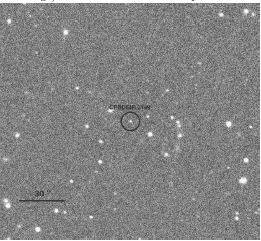

| Visitors Now: | |
| Total Visits: | |
| Total Stories: |

| Story Views | |
| Now: | |
| Last Hour: | |
| Last 24 Hours: | |
| Total: | |
Rogue Planet Found By Astronomers. As Large As Jupiter
Using the CFBDSIR wide field survey for brown dwarfs, astronomers identified CFBDSIRJ214947.2-040308.9, a late T dwarf with atypically red J − KS colour. The astronomers are P. Delorme T. Forveille X. Delfosse all at (UJF-Grenoble / CNRS-INSU, Institut de Plan´etologie et d’Astrophysique de Grenoble (IPAG) UMR 5274) J. Gagn´e 2 L. Malo Artigau L. Albert of D´epartement de physique and Observatoire du Mont M´egantic, Universit´e de Montr´eal, C.P. 6128, Succursale Centre-Ville, Montr´eal, QC H3C 3J7, Canada C. Reyl´e of Universit´e de Franche Comt´e, Institut UTINAM CNRS 6213, Observatoire des Sciences de l’Univers THETA deFranche-Comt´e, Observatoire de Besan¸con, BP 1615, 25010 Besan¸con Cedex, France and E. F. Allard and D. Homeier of C.R.A.L. (UMR 5574 CNRS), Ecole Normale Sup´erieure, 69364 Lyon Cedex 07, France
They obtained an X-Shooter spectra, with signal detectable from 0.8 μm to 2.3 μm, which confirmed a T7 spectral type with an enhanced Ks-band flux indicative of a potentially low-gravity, young, object.
The comparison of our near infrared spectrum with atmosphere models, for solar metallicity, shows that CFBDSIRJ214947.2-040308.9 is probably a 650-750K, log g=3.75-4.0 substellar object. Using evolution models, this translates into a planetary mass object, with an age in the 20-200 Myr range. An independent Bayesian analysis from proper motion measurements results in a 87% probability that this free-floating planet is a member of the 50-120 Myr old AB Doradus moving group, which strengthens the spectroscopic youth diagnosis.
By combining our atmospheric characterisation with the age and metallicity constraints arising from the probable membership to the AB Doradus moving group, we find that CFBDSIRJ214947.2-040308.9 is probably a 4-7 Jupiter masses free-floating planet with an effective temperature of 700K and a log g of 4.0, typical of the late T-type exoplanets that are targeted by direct imaging. We stress that this object could be used as a benchmark for
understanding the physics of the similar T-type exoplanets that will be discovered by the upcoming high contrast imagers
The scientific paper can be found here: http://arxiv.org/pdf/1210.0305v1.pdf
2012-11-15 02:07:33
Source: http://nanopatentsandinnovations.blogspot.com/2012/11/rogue-planet-found-by-astronomers-as.html
Source:



